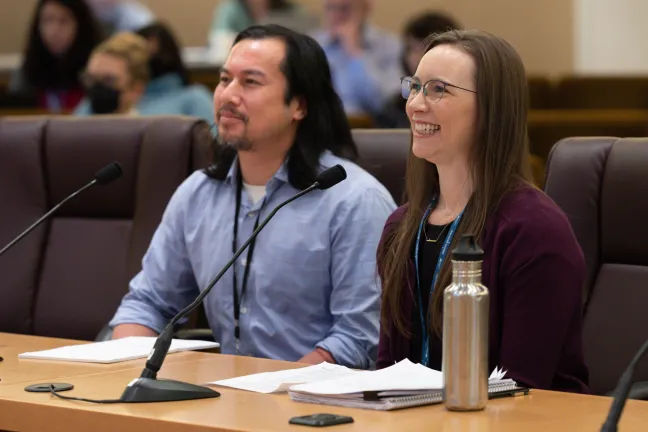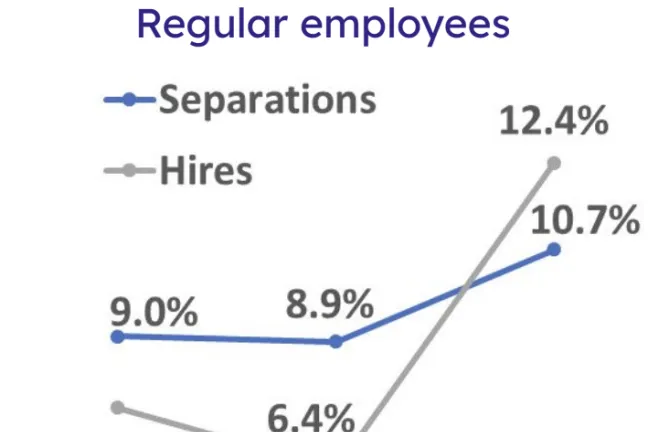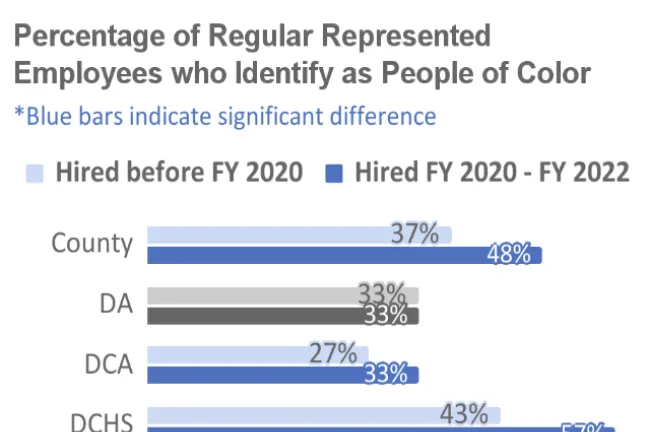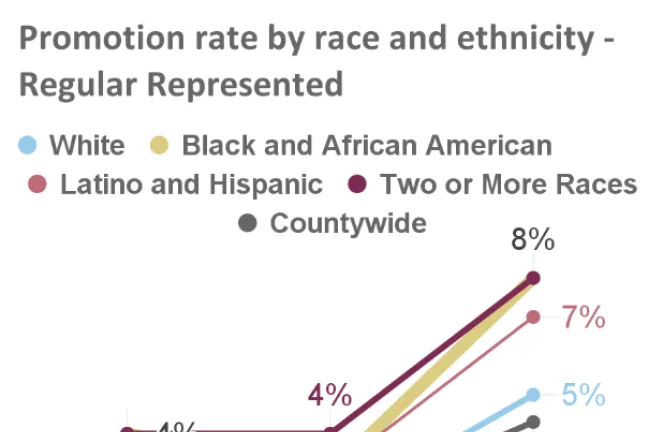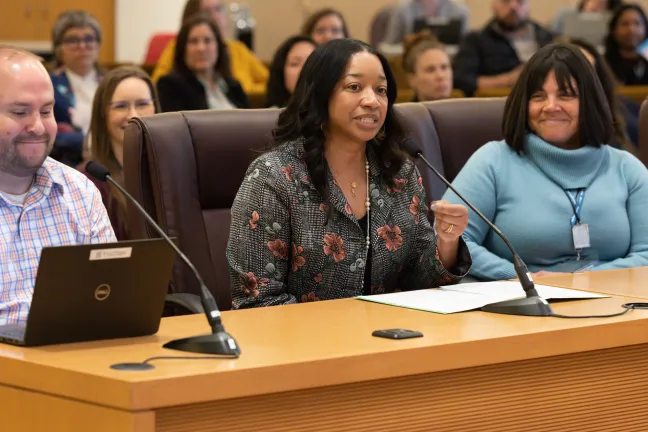Multnomah County’s workforce is becoming younger, more diverse and being buffeted by many of the trends seen in workplaces nationwide since the COVID-19 pandemic began three years ago.
And the County will be using those trends to better understand separations, improve worker retention and make and hold the organization to be more equitable, analysts told the Board of County Commissioners during the Thursday, March 23 board meeting.
The employment trends report, produced by the Department of County Management’s Evaluation and Research Unit (ERU), focuses specifically on workforce patterns over the 2020, 2021, and 2022 fiscal years, which spans the three-year period from July 1, 2019 to June 30, 2022. Data for the project were pulled from the County’s workforce system of record, Workday.
Presenters shared highlights of their quantitative analyses of workforce data, which examined trends in the hiring, retention, promotion and separation of Multnomah County employees during the reporting period. They also shared information about the changing demographic characteristics of the County workforce.
Chair Jessica Vega Pederson noted the goals of the report before the speakers shared their briefing, saying that reviewing employment trends supports the County’s workforce equity efforts, makes employment data more accessible and transparent and understands major organizational trends.
“At Multnomah County, we know that leading a diverse and dynamic workforce is more possible and more effective the more informed and reflective we are and can be,” said Vega Pederson. “Closely looking at workforce data will help the County be a workplace that is productive and supportive for all employees.”
Before diving into the findings, Dr. Alison Sachet, manager of the ERU, offered a reminder about the limitations of the report, saying that “our analysis of employment trends at Multnomah County cannot explain the ‘why’ behind the data.”
“Changes in any workforce reflect larger demographic trends and historical context, which are themselves products of systemic racism that influence historical hiring patterns and workplace culture, including within Multnomah County.”
She also cautioned that the findings in the report should be interpreted within the contexts of time and place.
“These data reflect trends resulting from important global, national and local events, including the COVID-19 pandemic, social justice movements and extreme weather events” that all took place during and throughout the reporting period, Sachet said.
Workforce trends findings
Sachet, along with senior research and evaluation analysts Drs. Timothy Ho and Jillian Girard of the ERU and Dr. Veronica Cano from the Office of Diversity and Equity (ODE), gave a detailed presentation of the many findings of the Multnomah County Employment Trends report.
Separation rates were stable between FY 2020 and FY 2021, but increased in 2022. The hiring rate decreased from 2020 to 2021, but increased in 2022 for “regular’’ employees. Regular employees are on-going, budgeted positions. There were also increases in hiring rates in FY 2021 for people hired for a limited duration and for a temporary time period. Limited duration employees are individuals hired into a position for up to two years. Temporary employees are individuals hired to meet short-term, non-recurring or emergency County work needs; usually for up to six months.
“The increase in limited duration and temporary employees may be attributed to the need for more staff to support the County’s response during the height of the COVID-19 pandemic,” Ho said.
The analyses revealed that newer employees are racially and ethnically more diverse than employees who were hired before FY 2020, with 48% of regular represented employees identifying as people of color. Represented employees are workers whose job is subject to a collective bargaining agreement between a labor union and the County. Among those regular represented employees hired before FY 2020, 37% identified as people of color.
“I appreciate the Employment Trends report showing that the diversity of the County workforce has increased for many employee demographics,” said Chief Diversity and Equity Officer Joy Fowler. “Hearing there was an 11% increase in employees who identify as people of color in those hired from 2020 to 2022 is impressive.”
Seven out of 11 County departments saw statistically significant increases in staff diversity over the past three fiscal years; three departments had increases in the percentages of employees of color that were not statistically significant, while one department did not see a change.
The racial and ethnic makeup of the countywide workforce of regular employees also became more diverse over the past three years. The share of regular employees who identify as people of color has steadily increased over the reporting period. In FY 2020, 36% of all regular employees identified as people of color, but by FY 2022, 40% of all regular employees identified as people of color.
In addition to increases in hiring and workforce diversity, regular represented Black and African American, Hispanic and Latino, and multi-racial employees (those who identify as being two or more races) received promotions at a higher rate than Regular Represented White employees, noted Cano.
The average age of employees is also trending younger, as a greater share of employees are coming from Generation Z (people born between 1997 and 2012) and Millennials (born between 1981 and 1996). Those generational groups have slowly increased in size over the past three years, while the Silent Generation (those born between 1928 and 1945) and Baby Boomers (born between 1946 and 1964) have decreased.
Along with the positive and progressive results in regards to diversity, presenters shared that they found results that represent both challenges and opportunities for growth. Ho explained some troubling employee departure trends from FY 2020 through FY 2022.
The rate of regular employees who are both represented and non-represented Black and African American employees who voluntarily separated from the County was higher compared to the countywide rate of Regular employees. The percentage of Black and African American employees voluntarily leaving rose steadily from 3.6% in FY 2020 to 7.8% in FY 2021, to 9.5% in FY 2022. Among Regular Represented employees who identify as being two or more races, the voluntary separation rate dipped from 6.2% in FY 2020 to 3.4% in FY 2021, then significantly increased to 9.8% in FY 2022.
“Some of the trends we saw in voluntary separation rates for specific groups are startling,” said Chief Human Resources Officer Travis Brown. “At the same time, I don’t think anyone can say the numbers totally caught us by surprise.”
While involuntary separations and no-fault separations (like layoffs) were infrequent for both demographic groups, countywide employees had higher retirement rates than Black and African American employees.
“The disparities in separation rates validate what Black and African American employees across all levels of the organization have been sharing regarding their experiences at the County,” Fowler said.
“If we want to be an organization that states we inclusively lead with race, we have to demonstrate that commitment not only through recruiting efforts but also through a retention strategy that is equally as effective.”
Employees with disabilities also experienced an increase in voluntary separations, from 2.7% in FY 2020 to 6.5% in 2021 and 8.8% in FY 2022. Ho cautioned that when the research team looked at demographics regarding disability status, there is unknown data for almost 50% of employees, meaning that employees have not entered their demographic information into the County’s Workday system. Similarly, there is also a substantial amount of unknown data — between 46% and 65% missing — about employees’ gender identity, sexual orientation and veteran status.
“With so much missing data in Workday, the interpretation of our findings reflecting employment trends related to certain demographics is limited,” Ho said.
Using data to cause change
Employees of color and employees who are part of other marginalized identities have long raised concerns about factors that might push them to find work elsewhere, Brown said.
Multnomah County is committed to transforming information into action by taking the report’s quantitative information, which helps to define the shape and breadth of the County’s employment challenges, and using it to create a better workplace.
“This information is important, but great analysis and detailed reports are useless if they sit on the shelf,” Chief Operating Officer Serena Cruz said.
“Continuing to transform what knew, and what we continue to learn through reports like this one, into action and improvement means finding opportunities to take action in the short-term, and ways to create sustainable change for the long term.”
Fowler announced several actions that the Office of Diversity and Equity will implement to continue looking into what is undermining the County’s efforts to retain employees of color:
- ODE will partner with Central Human Resources (HR) and Organizational Learning to organize employee forums, feedback from which will be shared with all HR teams to tailor strategies for improving retention at the department level.
- She and ODE will conduct both Stay and Exit Interviews for all senior leaders of color.
- ODE will also work with departing employees of color to identify, understand and elevate themes gathered from what they choose to share about their reasons for exiting the organization.
Brown followed by sharing several additional measures that will come out of a collaborative effort between the County’s Central HR, ODE, the Chief Operating Officer’s Office, the Complaints Investigation Unit (CIU), and department-level leadership:
- Department Directors will implement restorative team building at the department, division or work group level within 60 days of the recommendation before, during or after a protected class investigation.
- ODE, with support from Central and Departmental HR and the Complaints Unit, will follow up with staff in the work units that were required to implement restorative practices to evaluate the impacts and effectiveness of those interventions, and offer further support and actions if necessary.
- It is an established practice to allow managers to invite a representative of their choosing to join them in any meeting that they reasonably believe could result in a disciplinary action. To further support transparency, Central HR and ODE will work together to educate and support staff who are invited into this role.
- Department directors who face any issues with implementing Complaints Unit committee decisions will report back to the Protected Class Committee to find support strategies.
“The action steps coming out of ODE, the CIU and Central HR are practices that we believe can and will contribute to the improvement of culture, retention and employees’ experiences,” Cruz said.
Cruz went on to say that the Employment Trends report will feed into and inform what the upcoming renewal of the Workforce Equity Strategic Plan will look like.
“The renewed Workforce Equity Strategic Plan is going to offer us a roadmap for where we head next in our journey to becoming an equitable, safe and just place to work, and will provide even further accountability for what we’re trying to achieve with what we laid out today,” Cruz continued.
“I believe that as a County, we can both recognize the progress we’re making and commit ourselves to overcoming the steep challenges we continue to face.”
For more information:
Watch the full briefing here.
The full Multnomah County Employment Trends report, an executive summary, individual department summaries and data dashboards can be found here.
